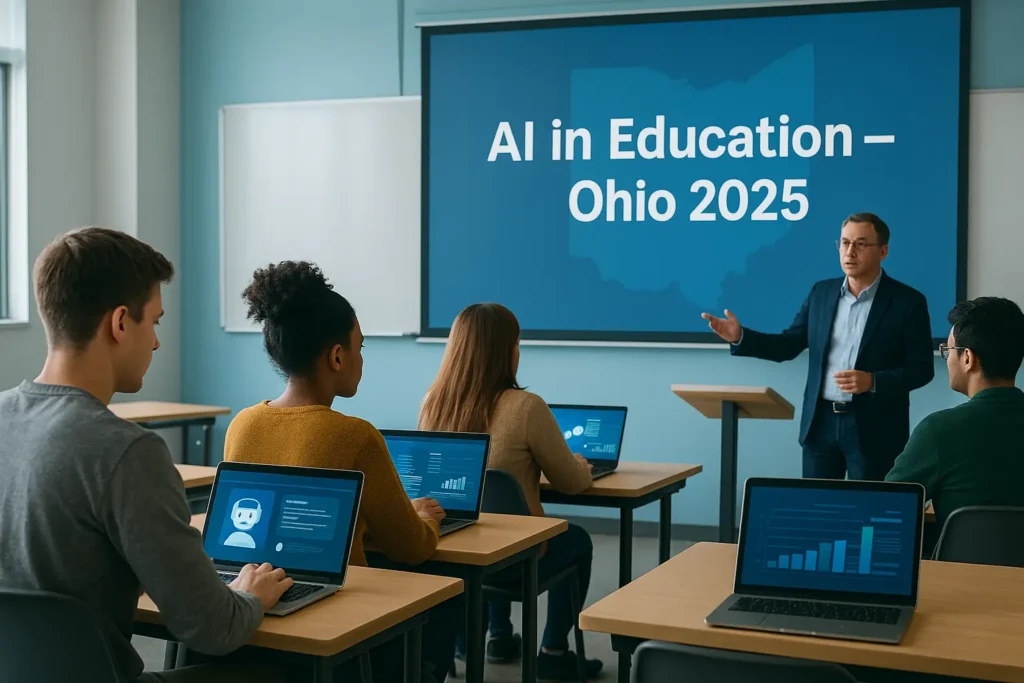Artificial intelligence isn’t just reshaping tech—it’s now transforming Ohio’s universities.
From new AI certificates to state-funded pilots and looming policy deadlines, schools across Ohio are moving quickly to prepare students for an AI-driven future. But experts warn that overreliance could weaken critical thinking, leaving universities balancing innovation with caution.
Key Takeaways
- 85% of Ohio students already use AI in schoolwork.
- Ohio State launches new campus-wide AI initiative this semester.
- State budget requires all K-12 schools to adopt AI policies by 2026.
- MIT research warns frequent AI use may erode critical thinking.
- Community colleges win $100K grants to pilot AI projects.
Ohio universities are rapidly adopting artificial intelligence in classrooms through new initiatives, courses, and state-backed programs. The Ohio budget requires AI policies in all K-12 schools by 2026, while colleges like Ohio State and Ohio University are launching programs to balance innovation with ethics and protect critical thinking.
Why AI Is Suddenly Everywhere in Ohio Classrooms
Artificial intelligence is moving from Silicon Valley into the heart of Ohio’s higher education system. With 85% of college students already using generative AI in their studies (TechTrends, June 2025), universities are scrambling to provide guidelines, training, and dedicated programs before the technology outpaces policy.
Ohio State University is leading the charge with a new campus-wide initiative aimed at teaching students both fluency and responsibility in AI use. “We’re not saying you have to use this tool,” said Ravi V. Bellamkonda, OSU’s provost. “We’re saying you need familiarity to know when it’s appropriate.”
The Policy Push From Columbus
The state’s two-year operating budget has made AI a legislative priority. It requires the Ohio Department of Education and Workforce to adopt a model AI policy by December 31, 2025, with all K-12 schools required to implement their own by July 1, 2026.
Lawmakers have also carved out resources for higher education. The AI Integration in Community Colleges Pilot Program awards five $100,000 annual grants to schools that launch AI-driven teaching or workforce initiatives.
At the same time, House Bill 392, sponsored by Reps. Tex Fischer and Steve Demetriou, seeks to regulate AI at the state level by defining how AI systems can generate content, make decisions, or influence environments.
Inside the Classroom: Balancing Tools and Risks
For faculty, the challenge lies in deciding when and where AI is appropriate. OSU is drafting new plagiarism guidelines to reflect AI’s growing role in assignments.
At Ohio University’s College of Business, professor Gaurav Bansal compares AI adoption to the arrival of calculators. “The use of calculators has not dumbed us down,” he said. “We found new ways to challenge our brains.”
But Bansal also warns that student fears about job loss in an AI-driven world are real. That’s why OU has launched an AI in Business graduate certificate and an AI concentration for its MBA program—to help students see AI as augmentation, not displacement.
Research and Risks
Not everyone is bullish. MIT’s Media Lab has raised concerns that frequent AI use may erode critical thinking, especially among younger students still learning problem-solving fundamentals.
Bellamkonda acknowledges the risk but argues universities must prepare students for a workplace where AI is ubiquitous. “Critical thinking becomes even more important in this age,” he said. “Only those who know how to engage AI intelligently will thrive.”
The Bigger Picture
Ohio’s experiment may offer a glimpse of what’s coming nationwide. As states grapple with AI’s role in education, Ohio is among the first to tie funding, deadlines, and legislation together into a statewide framework.
The state’s mix of large research universities, community colleges, and K-12 districts makes it a testbed for how AI can be responsibly integrated across all levels of education.
Conclusion
Ohio universities are embracing AI at a pace rarely seen in higher education. From new programs and pilot funding to looming state regulations, the next two years will determine whether AI becomes a tool that enhances student learning—or one that undermines it.
Source Ohio Capital Journal
